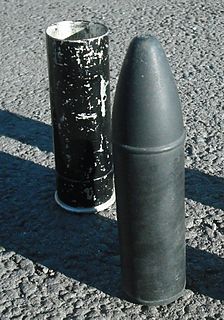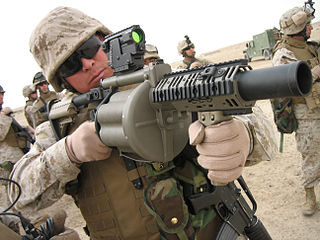
A firearm is a portable gun that inflicts damage on targets by launching one or more projectiles driven by rapidly expanding high-pressure gas produced chemically by exothermic combustion (deflagration) of propellant within an ammunition cartridge. If gas pressurization is achieved through mechanical gas compression rather than through chemical propellant combustion, then the gun is technically an air gun, not a firearm.

A bullet is a kinetic projectile and the component of firearm ammunition that is expelled from the gun barrel during shooting. The term is from Middle French and originated as the diminutive of the word boulle (boullet), which means "small ball". Bullets are made of a variety of materials such as copper, lead, steel, polymer, rubber and even wax. They are available either singly as in muzzleloading and cap and ball firearms or as a component of paper cartridges, but much more commonly in the form of metallic cartridges. Bullets are made in a large number of shapes and constructions depending on the intended applications, including specialized functions such as hunting, target shooting, training and combat.

A cartridge is a type of pre-assembled firearm ammunition packaging a projectile, a propellant substance and an ignition device (primer) within a metallic, paper or plastic case that is precisely made to fit within the barrel chamber of a breechloading gun, for the practical purpose of convenient transportation and handling during shooting. Although in popular usage the term "bullet" is often used to refer to a complete cartridge, it is correctly used only to refer to the projectile.

A muzzleloader is any firearm into which the projectile and usually the propellant charge is loaded from the muzzle of the gun. This is distinct from the more popular modern designs of breech-loading firearms. The term "muzzleloader" applies to both rifled and smoothbore type muzzleloaders, and may also refer to the marksman who specializes in the shooting of such firearms. The firing methods, paraphernalia and mechanism further divide both categories as do caliber.

Rubber bullets are rubber or rubber-coated projectiles that can be fired from either standard firearms or dedicated riot guns. They are intended to be a non-lethal alternative to metal projectiles. Like other similar projectiles made from plastic, wax, and wood, rubber bullets may be used for short range practice and animal control, but are most commonly associated with use in riot control and to disperse protests. These types of projectiles are sometimes called baton rounds. Rubber projectiles have largely been replaced by other materials as rubber tends to bounce uncontrollably.

In guns, particularly firearms, caliber or calibre is the specified nominal internal diameter of the gun barrel bore regardless of how or where the bore is measured and whether or not the finished bore matches that specification It is measured in hundredths or thousandths of an inch or in millimetres. For example, a ".45 caliber" firearm has a barrel diameter of roughly 0.45 inches (11 mm). Barrel diameters can also be expressed using metric dimensions. For example, a "9 mm pistol" has a barrel diameter of about 9 millimeters. Due to the inaccuracy and imprecision of imperial dimensions "converted" to metric units, metric designations are typically far out of specifications published in decimal inches. True "caliber" specifications require imperial measure, and even when cartridge designations only specify caliber to even tenths or hundredths of an inch, actual barrel/chamber/projectile dimensions are published to at least thousandths of an inch and frequently tolerances extend into ten-thousandths of an inch.

Fabrique Nationale Herstal, self-identified as FN Herstal and often referred to as Fabrique Nationale or simply FN, is a leading firearms manufacturer located in Herstal, Belgium, owned by the holding company Herstal Group which is in turn owned by the regional government of Wallonia. It is currently the largest exporter of military small arms in Europe.

The FN P90, also known as the FN Project 1990, is a compact personal defense weapon (PDW) designed and manufactured by FN Herstal in Belgium. Created in response to NATO requests for a replacement for 9×19mm Parabellum firearms, the P90 was designed as a compact but powerful firearm for vehicle crews, operators of crew-served weapons, support personnel, special forces, and counter-terrorist groups.

The .22 Long Rifle or simply .22 LR is a long-established variety of .22 caliber rimfire ammunition, and in terms of units sold is still by far the most common ammunition in the world today. It is used in a wide range of rifles, pistols, revolvers, smoothbore shotguns, and even submachine guns.
Internal ballistics, a subfield of ballistics, is the study of the propulsion of a projectile.

A blank is a type of firearm cartridge that contains gunpowder but no projectile, and instead use paper or plastic wadding to seal the propellant into the casing. When fired, the blank makes a flash and an explosive sound (report), and the firearm's action cycles from the recoil, but the wadding propelled from the barrel quickly loses kinetic energy and is incapable of inflicting any damage beyond an immediate distance. Blanks are often used for shooting simulations that demand light and sound, combat training, for signaling, and cowboy mounted shooting. Blank cartridges differ from the inert dummy cartridges, which contain no primer or gunpowder and are used for "cold" training or function-testing firearm actions.

The FN Five-seven, trademarked as the Five-seveN, is a semi-automatic pistol designed and manufactured by FN Herstal in Belgium. The pistol is named for its 5.7-mm (.224 in) bullet diameter, and the trademark capitalization style is intended to emphasize the manufacturer's initials—FN.

In current usage a riot gun or less-lethal launcher is a type of firearm that is used to fire "non-lethal" or "less-lethal" ammunition for the purpose of suppressing riots. Less-lethal launchers may be special purpose firearms designed for riot control use, or standard firearms, usually shotguns and grenade launchers, adapted to riot control use with appropriate ammunition. The ammunition is most commonly found in 12 gauge shotguns and 37mm/40 mm grenade launchers.

A riot shotgun is a shotgun designed or modified for use as a primarily defensive weapon, by the use of a short barrel and a larger magazine capacity than shotguns marketed for hunting. The riot shotgun is used by military personnel for guard duty and was at one time used for riot control, and is commonly used as a door breaching and patrol weapon by law enforcement personnel, as well as a home defense weapon by civilians. Guns of this type are often labeled as breaching shotguns, tactical shotguns or special-purpose shotguns to denote the larger scope of their use; however, these are largely marketing terms.

A handgun is a short-barrelled firearm designed to be fired with only one hand. The two most common handgun sub-types in use today are revolvers and semi-automatic pistols.

The FN 5.7×28mm (designated as the 5.7 × 28 by the C.I.P.) is a small-caliber, high-velocity, smokeless powder, rebated rim, bottlenecked, centerfire handgun and rifle cartridge designed and manufactured by FN Herstal in Belgium. It is similar in length to the .22 WMR (5.7×27mm)and to some degree similar also to .22 Hornet or .22 K-Hornet. Unlike many new cartridges, it has no parent case; the complete package was developed from scratch by FN. The 5.7×28mm was developed in conjunction with the FN P90 personal defense weapon (PDW) and FN Five-seven pistol, in response to NATO requests for a replacement for the 9×19mm Parabellum cartridge. In 2002 and 2003, NATO conducted a series of tests with the intention of standardizing a PDW cartridge as a replacement for the 9×19mm Parabellum cartridge. The tests compared the relative merits of the 5.7×28mm cartridge and the 4.6×30mm cartridge, which was created by Heckler & Koch as a competitor to the 5.7×28mm. The NATO group subsequently recommended the 5.7×28mm cartridge, citing superior performance in testing, but the German delegation objected and the standardization process was indefinitely halted.
Gun f/x Tactical Development is an R&D firm serving the paintball industry. It was founded as Gun f/x in 1994 as a spin-off of Pro-Team Products, Inc.

9mm P.A., 9×22mm or 9mm P.A.K. is a firearm cartridge for a non-lethal gas pistol noisemaking gun. Caliber 9mm P.A. includes various blank, gas or rubber ammunitions made for different use.

The Nebelpatrone or "fog cartridge" in English was a non-lethal smoke grenade that was developed by Germany and used by the Wehrmacht during World War II. The Nebelpatrone was designed to be fired from a Kampfpistole flare gun.


















